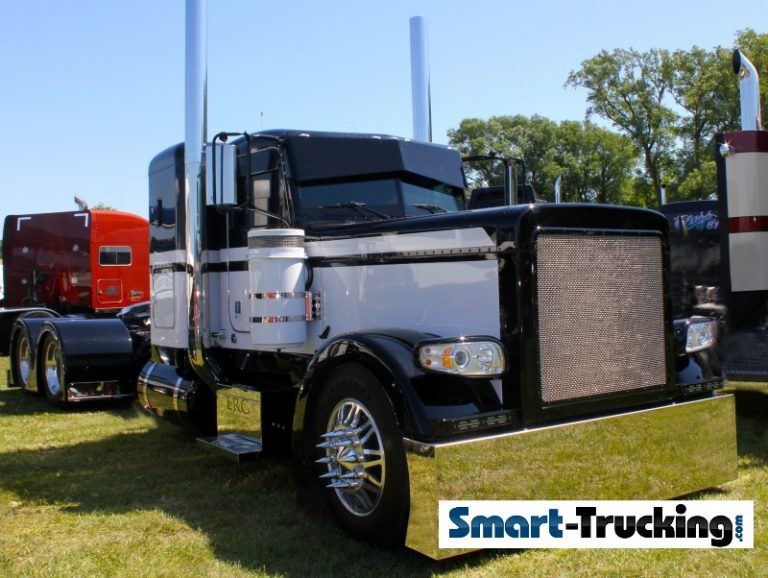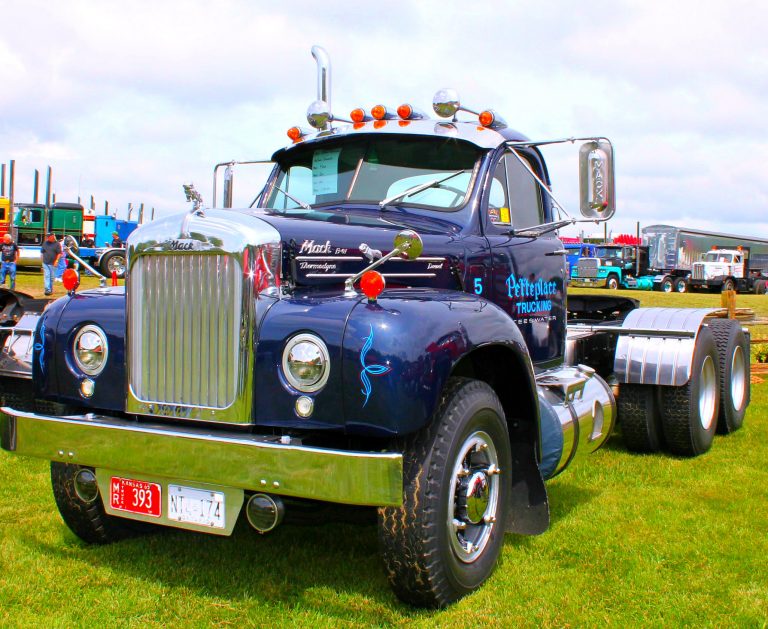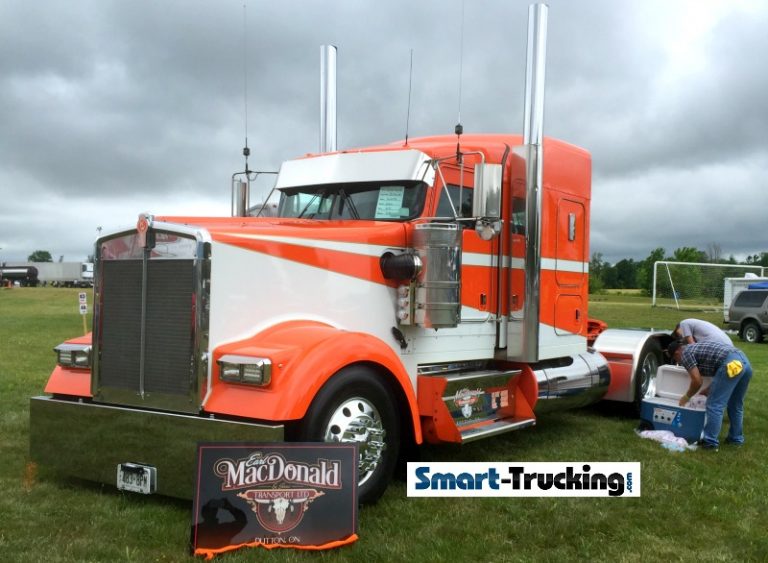The 18 Wheeler – A Comprehensive Guide to Big Rigs
If you’re confused as to what an 18-wheeler is, well they’re the largest trucks on the road.
They usually have two parts: The front is called the tractor unit, while the back is the semi trailer – with the cargo space.
In the business, an eighteen wheeler is called a “semi-trailer truck”.
They come in all shapes and sizes, and haul everything from fresh produce and steel, to cars, cattle, and gasoline.
They’re ever-present icons on America’s highways, and without them the nation’s economy would grind to a screeching halt.
For those who’ve never eased a heavy Freightliner down a mountain pass or backed a Kenworth under a loaded trailer, we’ll cover the basics first.
Most Popular Semi-Truck Brands in America
The following ‘Big 5’ manufacturers dominate the market for new Class 8 trucks in the United States:
Freightliner
Freightliner’s market share of new truck sales stands at nearly 40%.
They’re well-built, while have lower operating costs than many of their competitors, which makes them popular with fleets and business savvy owner-operators.
They’re also quite reasonably priced compared to the competition – with a mid-range 18 wheeler price at around the $130,000 mark.
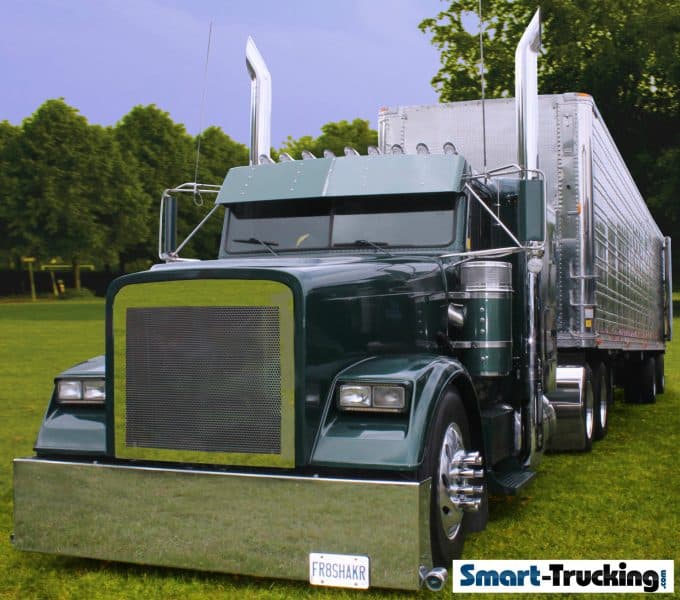
Peterbilt
Out on the open road, few truck brands command the respect that Peterbilt does.
Peterbilt trucks account for about 15% of annual new truck sales in the United States.
People know them for their long hoods and smooth ride. They’re the favorite truck for owner-operators looking for all the features.
Due to all these features, they can be a bit pricey. Mid-range Peterbilt trucks are at least $160,000 — but they do have a high resale value.
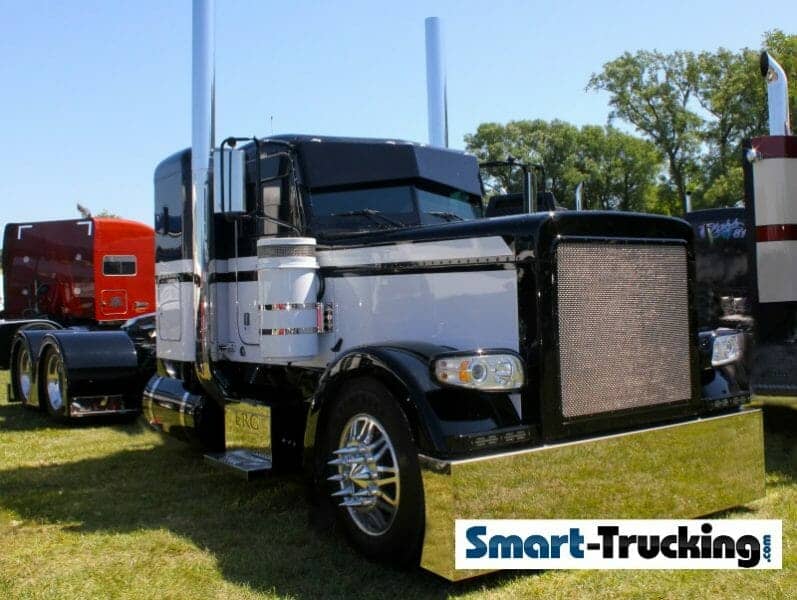
Kenworth
Kenworths are known for their rugged durability, well-appointed interiors, and across the board styling that ranges from the traditional W900 to the aerodynamic T680.
Paccar owns both Kenworth and Peterbilt, and Kenworth’s market share is also about 15% of the new truck market.
New Kenworth trucks typically start at $180,000.

Navistar International
Though they manufacture high-end trucks aimed at owner operators as well, International tractors are most popular with large fleets.
Navistar International trucks come in a variety of models appropriate for different applications. They have a reputation for standing up well in harsh working environments.
International’s market share is about 13%.
Compared with many of their competitors, Internationals are relatively inexpensive – with new prices at around $120,000 for a mid-range truck.
Volvo
Known for their ergonomic driver amenities, abundant engine options, and all-around value, Volvo tractors are becoming increasingly popular with fleets and cost-conscious owner operators.
They’re among the most aerodynamic and fuel efficient of all Class-8 trucks, and they’re manufactured as day cabs, heavy haulers, and over-the-road tractors.
Volvo’s share of the new truck market is about 9%.
Prices of a new Volvo truck are upwards of $140,000 – for a mid-range model.
Though they account for more than 80% of new sales every year, these manufacturers aren’t the only options.

For more information on other iconic American truck brands, click the links below:
Take a quick look at some of the most notable truck models from the past and present:
18 Wheeler Truck Facts
- Wheels: Though the smallest tractor trailers have just 10 and the largest dozens more, most big rigs have 18 wheels.
- Cargo Capacity: Big rigs cargo capacities can be over 40,000 pounds, and gross weights up to 80,000 pounds. They need all those wheels and tires to spread that bulk over the largest possible area.
- Dimensions: Standard tractor trailers are typically 13½ feet high, about 70 feet long, and have five axles. But those that haul oversized loads may be much higher, longer, and heavier.
- Turning Radius: Compared to family cars, trucks have huge turning radiuses. They need between 40 and 50% more distance to come to a complete stop. They can’t stop on a dime.
Speed and Fuel Mileage
Decades ago when fuel was cheap and regulation spotty, truckers commonly roared down the highway much faster than they do today.
Now most semi trucks have devices on their engines that limit speed. For fleets they’re typically set between 62 and 68 miles per hour for safety and economy. For owner-operators the speed limiters may be set much higher, or turned off altogether.
At 100,000 miles per year, the difference between 6 and 7 miles per gallon can equate to a savings of nearly $7,000.

Semi Truck Engines
We’ve already established that 18 wheelers are massive, powerful, and worthy of our respect. But it’s the part few ever get to see that does most of the heavy lifting.
Day and night, rain or shine, diesel engines toil away in their dark compartments subject to extreme conditions. These would turn any average gasoline engine into a smoldering hunk of plastic and aluminum.
Unlike car engines that rarely hit the 200,000 mile mark, it’s common for diesel truck engines to last 1 million miles or more! It’s also possible to rebuild them to extend their service lives even further.
Semis can have one gas tank or two, holding 300 gallons or more of diesel fuel. They are capable of traveling nearly 1,500 miles between fill ups.
The most common diesel engines manufacturers are Detroit Diesel, Cummins, Volvo, Mack, Navistar International and Paccar.
For years Caterpillar engines were among the most popular, but CAT no longer manufactures heavy-duty truck engines for on-highway use.
Power Output
Their power output depends on their size, application and the vehicle’s gross vehicle weight rating (GVWR).
Here’s a comparison between Class-8 trucks and cars:
| Class-8 trucks | Car engines | |
| Displacement | 12 – 15 liters | 3 – 5 liters |
| Horsepower | 400 – 500 | 150 – 250 |
| Torque | 1200 – 2000 | 200 – 300 |
Related > The Best Truck Engines + The Worst

Truck Transmissions, and How to Use them like a Pro
Most fleet trucks have 9 or 10 forward gears. Though they’re few and far between these days, cars with manual transmissions usually have only 5.
Owner-operators and heavy haulers typically spec their rides with bigger transmissions like 13 and 18 speeds.
They’re often necessary when transporting heavy loads in mountainous terrain.
Though fighting that many gears may seem like a daunting task, in the right hands they can make driving easier and more profitable by reducing the number of shifts and increasing fuel economy.
Interested in learning how to shift an 18-speed? Check how the pros do it!
Traditionally, nearly all tractor-trailers were equipped with manual transmissions.
But in the never-ending quest to save fuel and accommodate inexperienced drivers, many fleets have switched to automatics.
Old-school truckers and owner operators tend to shun them like they do low-calorie sugar substitutes and decaffeinated coffee.
They’re perceived as less responsive, more dangerous when driving on snow and ice, and just plain boring.
But data shows that when driven properly they use less fuel, so they’re definitely here to stay.

18 Wheeler Equipment
Fifth Wheels and Kingpins
Fifth wheels are the large u-shaped slabs of steel bolted to the tractor’s frame behind the cab.
Kingpins are the arm-sized steel pins that protrude from underneath the front of trailers.
When the tractor is backed under the trailer the kingpin slides into the fifth wheel. When done correctly, it’s powerful jaws instantly lock it into place.
But be warned, if those jaws don’t grab that kingpin like they’re supposed to, you may be in for the shortest trip in the history of trucking.
Related > How to Slide the Fifth Wheel
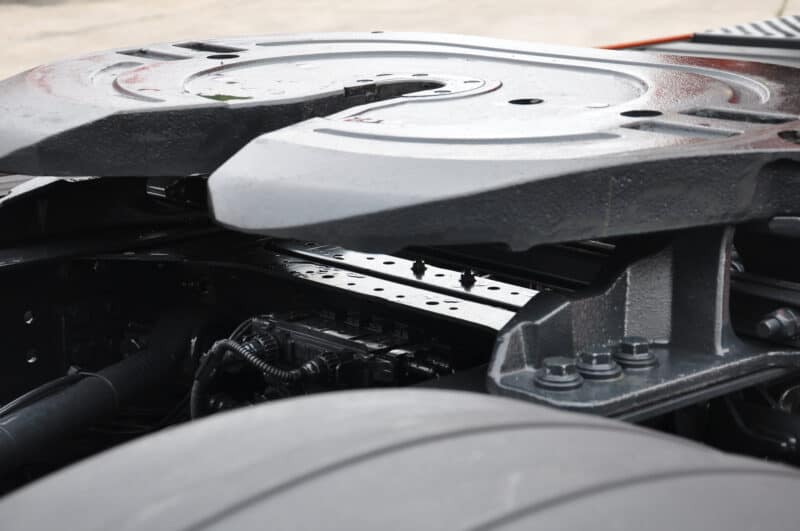
Axles
Nearly everyone is familiar with axles, but tractor-trailers have steer axles, drive axles, and trailer axles.
Though steer and trailer axles are pretty self-explanatory, drive axles are at the back of the tractor. They connect to the engine via the driveshaft.
These axles take all that power from the diesel and use it to propel the truck forward and backward. Some tractors have one drive axle, but most have two.
Fairings and Skirts
These days most trucks have fairings and skirts.
They’re long thin sections of metal, fiberglass or plastic slung under the trailer, and they help trucks slide through the air with less resistance.
Sometimes they’re only on the tractor, but they’re becoming more common on trailers too.
Their jobs are to improve aerodynamics and increase fuel efficiency thereby decreasing the vehicle’s operating costs.
Tractors have had fairings on their roofs, over their fuel tanks, and behind their cabs for decades, but trailer skirts are relatively new.
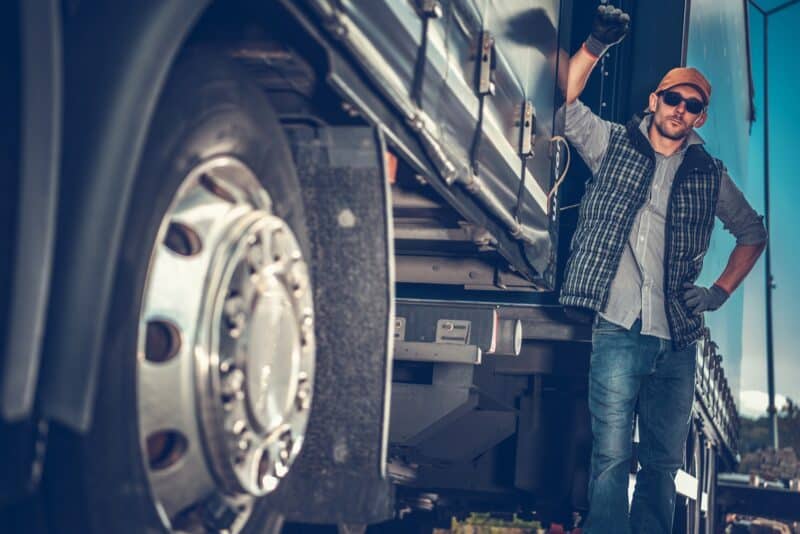
Trucking Terms Worth Knowing
From bobtails and day cabs, to doubles and reefers, the trucking terms and phrases used by truckers referring to 18 wheeler trucks, can be downright confounding.
But thankfully, most of them aren’t difficult to learn.
Here are a few easy examples:
- Bobtailing: if you’re driving a tractor without a trailer
- Reefer: if you’re pulling a trailer equipped with a temperature controlled unit
- Dry Vans: standard trailers used for hauling general freight
- Day cabs : tractors without sleepers
- Sleeper Berth Trucks: trucks with sleeping facilities
- Doubles: Truck pulling more than one trailer
- B-Trains: Double trailer configurations that may be nearly 90 feet long
Now let’s look at a few that require more explanation:
Double Clutching
In cars that have manual transmissions, when the driver depresses the clutch it allows the shift lever to slip easily into the next gear.
That’s because their transmissions are synchronized, but on 18 wheelers, transmissions are unsynchronized.
To get around this, commercial drivers must use a method called double clutching when working their way through the gears.
Double clutching involves briefly placing the transmission in neutral before moving on to the next higher gear.
The process is similar when downshifting.
But in this instance the driver will also need to tap the accelerator to get the engine RPMs into the sweet spot before the transmission will do what he wants it to.
Wheelbase
For twin-screw or tandem drive tractors (those with two drive axles), the wheelbase is calculated by measuring the distance between the center of the steer axle’s hub and the point between the two drive axle hubs.
On a single axle tractor, the measurement is from the center of the steer-axle’s-hub to the center of the drive axle’s hub.
It’s important to note that the wheelbase is one of those trucking issues that’s perpetually shrouded in controversy, confusion, and misinformation. This is due to a myriad of state and federal regulations. These can confuse even the most seasoned truckers.
So plan ahead if you’ll be operating in multiple states.

Weight Limits
The maximum gross weight for tractor-trailers engaged in interstate commerce in the United States is 80,000 pounds.
Trucks are allowed much higher gross weights when hauling oversized loads like mining equipment and transformers, but they need special permits (and probably escorts) in each state through which they’ll travel.
For standard 5 axle semis, the maximum allowable axle weights are:
- 12,000 pounds on the steer axle
- 34,000 pounds on the drive axles (on a tandem drive tractor)
- 34,000 pounds on the trailer axles
If you’ll be hauling freight into and out of Canada, you’ll need to familiarize yourself with their weight limits as well.
Buying a Big Rig
Though they sure are nice to look at, shiny new trucks with chrome stacks, aluminum wheels, and posh sleepers may not be wise choices for first-time drivers.
The trucking industry is fraught with hard to understand regulations, unexpected pitfalls, and economic factors that can vary greatly from one month to the next.
Many new drivers spend a year or two driving company trucks before making the leap to owning their own rig.
If buying is right for you, and you’re looking for 18 wheelers for sale, then you should consider the following questions:
Related > 10 Sure Fire Tips For Spec’ing the Right Truck
Should I buy a new or used truck?
In most cases new trucks look better, drive better, and smell better than their used cousins. They also come with warranties—and price tags that often top $130,000.
Sometimes those warranties don’t offer the protection that buyers think they do, and these days many used trucks come with warranties of their own.
In many instances, well-maintained, low-mileage tractors are great alternatives to new ones.
Related > Tips For Buying a Used Big Rig
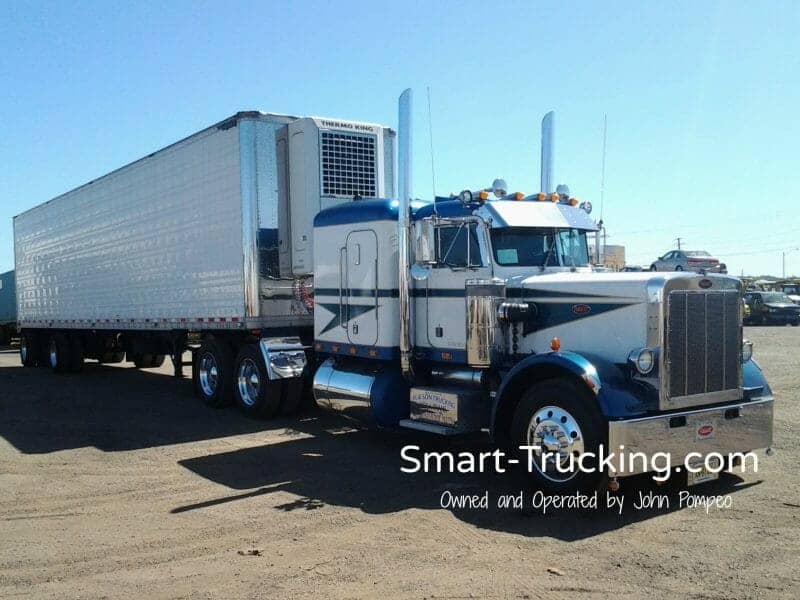
Where can I buy a big rig?
If you’re buying new you’ll be dealing with an official manufacturer’s dealership, but if you go the used route you’ll have the option of buying from used truck lots and private sellers.
Many new truck dealerships also offer gently-used and factory reconditioned trucks, and for those looking for peace of mind, they’re generally safer bets than the other two options.
That being said, some of the best used truck deals you’ll ever find will come from owner operators. Look for ones who have meticulously maintained their rides over the years.
In this case, they should have the receipts to prove it.
How will I finance my truck?
If you’ll be operating under your own authority, you’ll need to pay for your truck with cash or finance it through a bank.
If financing is the only option, you need to provide documentation like a freight contract, or proof that you’ve successfully completed a truck lease or purchase in the past.
Large carriers with owner operator divisions may also have financing options available.
Find more specific truck financing information here.
Can I lease a truck from a trucking company?
Yes you can, but that doesn’t mean you should.
Lease operator programs can seem like an attractive option for those making the transition from company driver to owner operator.
But in many instances carrier leases are little more than a scheme trucking companies use to prey on unwitting drivers by saddling them with the risk of owning a truck, without actually passing on any of the rewards.
Though there may be decent options out there, they’re definitely the exception to the rule.
If you find an opportunity to lease a truck from a carrier you think is reputable, have an attorney review their lease agreement before signing on the dotted line.
Related > Which is Better? Company Driver or Owner Operator Career?
Other considerations…
Before making a big decision like buying or leasing a truck, it’s always a good idea to talk with those who’ve already done it.
That means current and former drivers—especially those who’ve worked with the company you’re considering, or who have experience running under their own authority.
Hands down they’re going to be your best resource, so seek them out and pick their brains.
Insuring your Investment
Insurance. The very mention of it tends to cause drivers undue confusion and irritation. It’s an expensive but necessary evil for those interested in buying and operating their own truck. But it’s not as complicated as it’s made out to be.
First, determine what insurance you’ll need based on federal and state regulations, the type of truck you’ll be buying, what you’ll haul, and where you’ll haul it.
Find lots of useful information regarding insurance.

Learning to Drive an 18 Wheeler
Operators of commercial vehicles like tractor-trailers, dump trucks, and cement mixers need CDLs.
CDLs come in three classes: A, B, and C.
To drive tractor-trailers with gross weights up to eighty thousand pounds, you’ll need a class A license.
Commercial truck driver training is readily available. It’s offered by large carriers with their own driving academies, independent schools, and some community colleges.
Some large carriers subsidize the cost of training for trucking school graduates who commit to working for them when they get their licenses.
They’ll typically reimburse students a small percentage of the school’s cost over a number of months until they’ve met their employment obligation.
We have lots more information on paid CDL training.
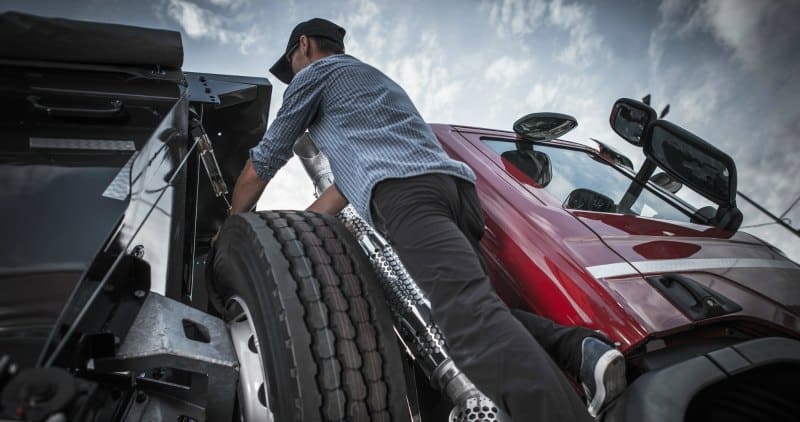
Driver Pay and Demographics
Truckers pay can run the gamut from peanuts to big bucks, but most drivers’ pay falls somewhere in the middle.
Though they face the toughest driving conditions, long stretches away from their families, and excessive oversight and regulation, over-the-road truckers often make less money than local drivers.
Detailed truck driving jobs pay statistics.
Though men account for nearly 90% of commercial drivers, women are entering the industry with increasing frequency. It’s a trend that’s caught the eye of big fleets, who are increasingly seeking out women as an alternative source of drivers.
Fun Trucking Games and Apps
Trucking is a tough business.
It’s full of stressful situations, mind-boggling regulations, and serious safety concerns, but it’s possible to get a taste of the trucking life without all the hassle.
Go ahead. Take it for a spin.

More Articles You May Like
- 5 Best GPS For Truckers – A Professional Driver’s Guide
- CDL Truck Driver Skills – Tips, Tricks + Knowledge to Kick Your CDL Skills Up a Notch!
- Learn How to Talk CB Lingo Like a Trucker, C’Mon!
- Best Truck Engines + The Worst Truck Engines – A Trucker’s Guide
- The Best Trucker Apps – For On the Road + Off!

AS SEEN ON THE POPULAR YOUTUBE CHANNEL!
